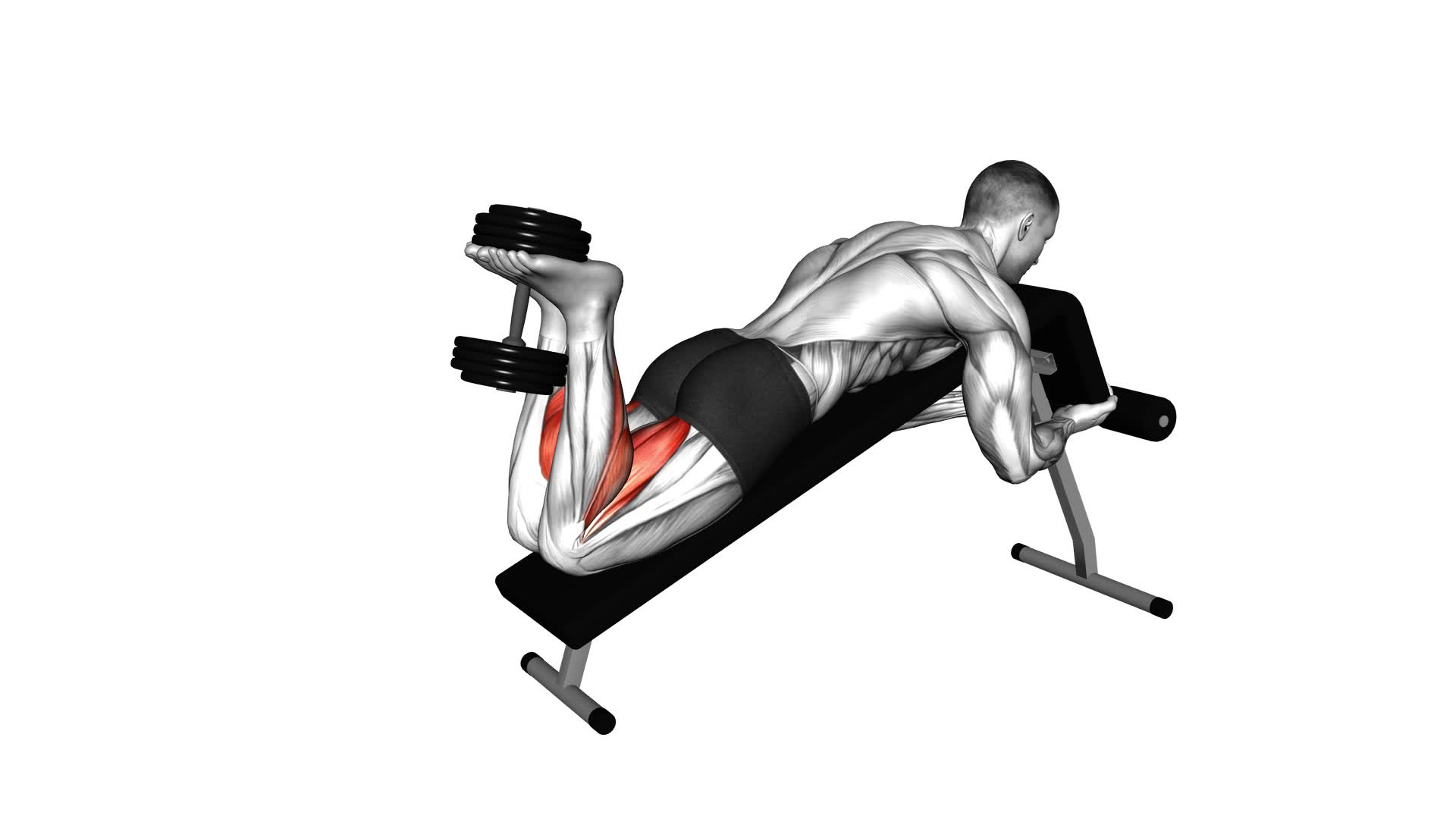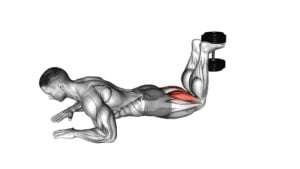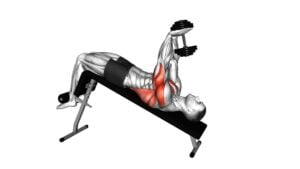Dumbbell Decline Lying Leg Curl – Video Exercise Guide & Tips

You'll love the Dumbbell Decline Lying Leg Curl for its efficient and effective lower body workout.
Watch This Exercise Video
In this video exercise guide, we'll show you the proper form and technique to maximize results.
Discover tips to increase intensity and avoid common mistakes.
Plus, try variations and modifications to keep your routine challenging and engaging.
Get ready to strengthen and tone your legs with this dynamic exercise.
Let's dive in and get started!
Key Takeaways
- Targets hamstring muscles effectively
- Improves lower body strength and stability
- Increases flexibility in the hamstrings
- Engages glutes and calves as secondary muscles
Benefits of the Dumbbell Decline Lying Leg Curl
You can experience a range of benefits from incorporating the dumbbell decline lying leg curl into your workout routine. This exercise is highly effective for targeting your hamstring muscles, which are located at the back of your thighs.
By strengthening and toning these muscles, you can improve your overall lower body strength and stability. The dumbbell decline lying leg curl also helps to increase flexibility in your hamstrings, allowing for a greater range of motion in your hip and knee joints. This can be particularly beneficial for athletes and individuals involved in activities that require explosive movements, such as sprinting and jumping.
Additionally, the exercise engages your glutes and calves as secondary muscles, further enhancing the overall effectiveness of the workout. The dumbbell decline lying leg curl is a versatile exercise that can be easily modified to suit different fitness levels and goals.
To ensure you get the most out of this exercise, it's important to maintain proper form and technique.
Proper Form and Technique for the Exercise
To perform the dumbbell decline lying leg curl with proper form and technique, focus on maintaining a stable body position and controlled movements throughout the exercise.
Start by lying face down on a decline bench, with your ankles secured under the foot pad. Hold a dumbbell between your feet, ensuring a firm grip. Engage your core and glutes to stabilize your body throughout the movement.
As you begin the exercise, exhale and flex your knees, bringing the dumbbell towards your glutes. Keep your upper body stationary and avoid using momentum to lift the weight. Pause for a moment at the top of the movement, squeezing your hamstrings.
To avoid common mistakes, ensure that you don't excessively arch your lower back or allow your hips to lift off the bench while curling the weight. Keep your movements controlled and avoid swinging or jerking motions.
Variations and modifications can be made by adjusting the weight of the dumbbell or using ankle weights instead. Additionally, you can perform the exercise using a stability ball instead of a decline bench to increase the challenge for your core muscles.
Tips for Increasing Intensity and Difficulty
To increase the intensity and difficulty of the dumbbell decline lying leg curl, consider incorporating advanced variations and adding more resistance. One way to do this is by using heavier dumbbells or increasing the number of sets and repetitions. By increasing the resistance, you challenge your muscles more and stimulate further growth and strength gains.
Another advanced technique to try is the single-leg variation. Instead of using both legs to perform the exercise, focus on one leg at a time. This requires more stability and engages the muscles on a deeper level.
Additionally, you can experiment with tempo variations. Slow down the eccentric phase of the exercise, where you lower the weight, to increase the time under tension and make the exercise more challenging. You can also try incorporating pauses at different points in the movement to increase the intensity.
By implementing these advanced techniques and increasing the resistance, you'll push your limits and continue to make progress.
Now, let's move on to the next section and discuss common mistakes to avoid.
Common Mistakes to Avoid
Continuing from the previous section, here are some common mistakes to avoid when performing the dumbbell decline lying leg curl:
- Using momentum: Avoid swinging your legs or using momentum to lift the dumbbell. This reduces the tension on your hamstrings and shifts the focus away from the targeted muscles.
- Lifting your hips: Keep your hips and lower back pressed firmly against the bench throughout the entire movement. Lifting your hips off the bench takes away the resistance from your hamstrings and places unnecessary stress on your lower back.
- Not controlling the weight: Maintain control over the dumbbell throughout the exercise. Avoid allowing it to drop quickly or jerkily, as this can lead to muscle strains or other injuries.
By avoiding these common mistakes and focusing on proper form, you can ensure that you're getting the most out of the dumbbell decline lying leg curl exercise.
Now, let's move on to the next section and explore some variations and modifications you can try to add variety to your leg workout routine.
Variations and Modifications to Try
To add variety to your leg workout routine, try incorporating variations and modifications of the dumbbell decline lying leg curl exercise. There are several alternatives you can try to target your leg muscles in different ways.
One option is to perform the exercise with a resistance band instead of dumbbells. This will add an extra challenge to your leg curls and engage your muscles differently.
Another alternative is to use a stability ball instead of a decline bench. This will require more core stabilization and increase the difficulty of the exercise.
Additionally, you can try doing single-leg curls instead of using both legs at the same time. This will help to isolate each leg and improve balance and stability.
If you're looking for progressions, you can gradually increase the weight of the dumbbells or resistance band as you get stronger. You can also increase the number of repetitions or sets you perform.
Another progression is to perform the exercise on an incline bench instead of a decline bench. This will shift the focus to different muscles in your legs.
Remember to always maintain proper form and listen to your body. Incorporating these alternatives and progressions will help keep your leg workout routine challenging and effective.
Frequently Asked Questions
Is the Dumbbell Decline Lying Leg Curl Suitable for Beginners?
The dumbbell decline lying leg curl may not be the best exercise for beginners. It requires a good amount of strength and stability.
However, there are modifications you can make to make it more beginner-friendly. For example, you can start with lighter weights or even use a resistance band instead of dumbbells.
It's important to avoid common mistakes like lifting your hips or using momentum to complete the movement. Proper form and control are key.
Can the Dumbbell Decline Lying Leg Curl Help in Building Muscle Mass?
The dumbbell decline lying leg curl can definitely help in building muscle mass. By targeting the hamstring muscles, this exercise allows for a concentrated and effective workout. It also engages the glutes and lower back, providing additional benefits.
To make the most out of this exercise, it's recommended to try different variations such as using different dumbbell weights or adjusting the decline angle. This will help in challenging your muscles and promoting muscle growth.
How Does the Dumbbell Decline Lying Leg Curl Compare to Other Leg Curl Exercises?
The dumbbell decline lying leg curl is a variation of the traditional leg curl exercise. It targets the hamstrings and glutes, just like the traditional leg curl, but with the added benefit of using dumbbells for added resistance.
This exercise can help improve strength and muscle definition in the lower body. Compared to other leg curl exercises, the dumbbell decline lying leg curl offers a unique challenge and can be a great addition to your leg workout routine.
Are There Any Safety Precautions to Consider While Performing the Dumbbell Decline Lying Leg Curl?
When performing the dumbbell decline lying leg curl, it's important to keep safety precautions in mind.
Make sure to start with a weight that you can handle comfortably and maintain proper form throughout the exercise.
Avoid using momentum or jerking motions, as this can increase the risk of injury.
If you don't have access to a decline bench at home, you can modify the exercise by using a stability ball or performing a standing leg curl with resistance bands.
Can the Dumbbell Decline Lying Leg Curl Be Performed at Home Without a Decline Bench?
To perform the dumbbell decline lying leg curl at home without a decline bench, you can try alternative exercises that target the same muscle groups.
One option is the lying leg curl on a stability ball or using resistance bands. These modifications can help you achieve a similar workout without the need for specialized equipment.
Remember to maintain proper form and consult a professional if you have any concerns or questions about performing these exercises safely.
Conclusion
In conclusion, the dumbbell decline lying leg curl is a beneficial exercise for targeting the hamstrings and glutes. By maintaining proper form and technique, individuals can maximize the effectiveness of this exercise.
Increasing intensity and difficulty can be achieved by adjusting the weight, tempo, or range of motion. It's important to avoid common mistakes such as using momentum or improper alignment.
Additionally, variations and modifications can be explored to add variety to the workout routine.

Author
Years ago, the spark of my life’s passion ignited in my mind the moment I stepped into the local gym for the first time. The inaugural bead of perspiration, the initial endeavor, the very first surge of endorphins, and a sense of pride that washed over me post-workout marked the beginning of my deep-seated interest in strength sports, fitness, and sports nutrition. This very curiosity blossomed rapidly into a profound fascination, propelling me to earn a Master’s degree in Physical Education from the Academy of Physical Education in Krakow, followed by a Sports Manager diploma from the Jagiellonian University. My journey of growth led me to gain more specialized qualifications, such as being a certified personal trainer with a focus on sports dietetics, a lifeguard, and an instructor for wellness and corrective gymnastics. Theoretical knowledge paired seamlessly with practical experience, reinforcing my belief that the transformation of individuals under my guidance was also a reflection of my personal growth. This belief holds true even today. Each day, I strive to push the boundaries and explore new realms. These realms gently elevate me to greater heights. The unique combination of passion for my field and the continuous quest for growth fuels my drive to break new ground.



